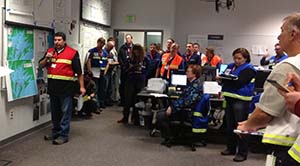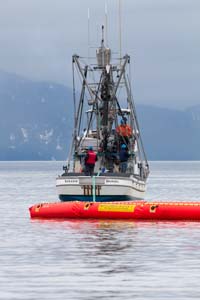By ROY ROBERTSON
Council Project Manager
This past October 3 and 4, Tesoro conducted the annual large-scale oil spill response exercise to test the Prince William Sound Tanker Oil Discharge Prevention and Contingency Plan.
The scenario imagined that, during inclement weather, an outbound partially loaded tanker struck an unknown object near Glacier Island and suffered a breached hull. The tanker instantaneously released a simulated 20,000 barrels of North Slope crude oil. The vessel sustained no further damage and the bad weather eased as the response continued with no further release of oil.
The first 12 hours of the exercise was led by Alyeska’s Ship Escort/Response Vessel System, or SERVS, as would happen in the case of a real spill.
After 12 hours, Tesoro’s response team took command of the response efforts, with continued help from SERVS.
The main focus of this year’s exercise was to test the following objectives:
• Communications between the command center in Valdez and the field regarding equipment staging and protection of shorelines, nearshore areas, and wildlife
• Logistical support for tracking the operation and resources
• Use of the fishing vessel oil spill response fleet
• Management, staffing, and set-up of equipment staging areas
The drill was a table-top exercise. No equipment or vessels were deployed except for equipment staging areas in Cordova and Whittier.
Council staff participated in various roles and helped evaluate the responders.
Some lessons were noted by the council evaluators:
• Communications between the equipment staging areas and the command post could be improved.
• An actual incident would require more Internet connections and phone lines at the command center.
• The coordination of the wildlife efforts could be improved to insure a more efficient response to the oiled wildlife.
This exercise provided a very good interaction between the industry and agencies’ response teams.
Terminal exercise conducted in November
On November 8, Alyeska conducted an exercise at the Valdez Marine Terminal.
This exercise imagined a 90,000-barrel crude oil spill into the Port of Valdez due to ruptured piping at one of the terminal’s loading berths. The spilled oil moved toward the city of Valdez, so city officials participated as part of the spill response leadership team, known as the Unified Command. Council staff members served as evaluators or as part of the drill team.
This exercise was a precursor to next summer’s National Preparedness for Response Exercise Program, which will be led by the Coast Guard. There was good participation by the Coast Guard and the state agencies in November’s exercise. One of the high points of this exercise was a change in the trajectory from the scenario in the plan that pushed oil toward the city of Valdez.
This caused response actions that focused on protecting the public. Lessons noted by council evaluators included:
• Notifications need to be improved.
• Reorganization of the Valdez Emergency Operations Center made the space more efficient.
• This drill used real time as opposed to the artificial timeframes used in other drills. This made the activities more realistic.
Whittier spill response exercise
On December 7, SERVS conducted an oil spill response exercise in Whittier.
Local fishing vessels, part of the industry’s oil spill fishing vessel response program, participated in the exercise. All the fishing vessels were Tier 1. Tier 1 boats are the earliest responders in case of a spill.
Participants were able to practice tactics such as exclusion and deflection booming. These tactics would be used in case of a real spill, to direct oil away from environmentally sensitive areas.
Council staff was on hand to observe the drill activities.

